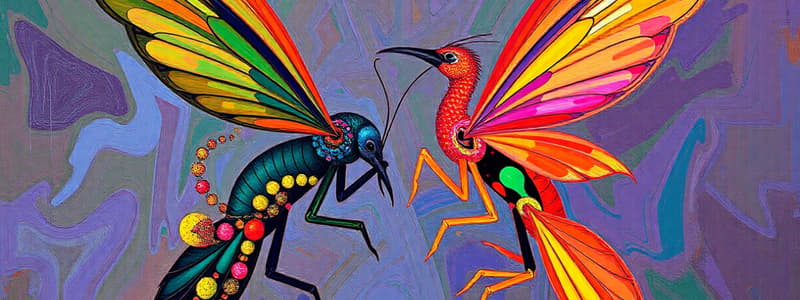Podcast
Questions and Answers
What defines a species according to the biological species concept?
What defines a species according to the biological species concept?
What is the morphological species concept based on?
What is the morphological species concept based on?
What happens to genetically identical organisms, like monozygotic twins, as they develop?
What happens to genetically identical organisms, like monozygotic twins, as they develop?
Which of the following is NOT a rule for binomial nomenclature?
Which of the following is NOT a rule for binomial nomenclature?
Signup and view all the answers
What is a genus in the context of biological classification?
What is a genus in the context of biological classification?
Signup and view all the answers
Which of the following statements about species is false?
Which of the following statements about species is false?
Signup and view all the answers
What does the term 'binomial' refer to in taxonomy?
What does the term 'binomial' refer to in taxonomy?
Signup and view all the answers
Why is variation among organisms important in biology?
Why is variation among organisms important in biology?
Signup and view all the answers
What does the presence of fertile offspring like Horse 3 indicate about Horses 1 and 2?
What does the presence of fertile offspring like Horse 3 indicate about Horses 1 and 2?
Signup and view all the answers
What defines a mule in terms of species classification?
What defines a mule in terms of species classification?
Signup and view all the answers
Which of the following is considered a challenge to the biological species concept?
Which of the following is considered a challenge to the biological species concept?
Signup and view all the answers
What is the most significant outcome of speciation?
What is the most significant outcome of speciation?
Signup and view all the answers
How can two populations be considered the same species despite rarely interbreeding?
How can two populations be considered the same species despite rarely interbreeding?
Signup and view all the answers
Which statement is true about the divergence of non-interbreeding populations?
Which statement is true about the divergence of non-interbreeding populations?
Signup and view all the answers
What may complicate the identification of species in rapidly speciating populations?
What may complicate the identification of species in rapidly speciating populations?
Signup and view all the answers
Which of the following is a key aspect of the biological species concept?
Which of the following is a key aspect of the biological species concept?
Signup and view all the answers
What is the diploid chromosome number for humans?
What is the diploid chromosome number for humans?
Signup and view all the answers
Which of the following statements about chromosome number changes is true?
Which of the following statements about chromosome number changes is true?
Signup and view all the answers
How are chromosomes classified when creating a karyotype?
How are chromosomes classified when creating a karyotype?
Signup and view all the answers
What is the haploid chromosome number that represents the sex cells in humans?
What is the haploid chromosome number that represents the sex cells in humans?
Signup and view all the answers
Which hypothesis relates to the formation of human chromosome 2?
Which hypothesis relates to the formation of human chromosome 2?
Signup and view all the answers
What type of cells undergo division to study chromosomes for karyotyping?
What type of cells undergo division to study chromosomes for karyotyping?
Signup and view all the answers
Why do diploid cells have an even number of chromosomes?
Why do diploid cells have an even number of chromosomes?
Signup and view all the answers
What are the characteristic chromosome types in a species collectively called?
What are the characteristic chromosome types in a species collectively called?
Signup and view all the answers
Which statement accurately describes the relationship between the long arm of chimp chromosome 13 and human chromosome 2?
Which statement accurately describes the relationship between the long arm of chimp chromosome 13 and human chromosome 2?
Signup and view all the answers
What is predicted to be found in the region where the fusion of chimp chromosomes is hypothesized to have occurred?
What is predicted to be found in the region where the fusion of chimp chromosomes is hypothesized to have occurred?
Signup and view all the answers
What does the presence of remnants of a second centromere in chromosome 2 suggest?
What does the presence of remnants of a second centromere in chromosome 2 suggest?
Signup and view all the answers
Which statement reflects the strength of the evidence regarding the fusion of chimp chromosomes in the evolution of human chromosome 2?
Which statement reflects the strength of the evidence regarding the fusion of chimp chromosomes in the evolution of human chromosome 2?
Signup and view all the answers
What comprises the genome of an organism?
What comprises the genome of an organism?
Signup and view all the answers
What causes diversity within a species?
What causes diversity within a species?
Signup and view all the answers
Which of the following statements about alleles is correct?
Which of the following statements about alleles is correct?
Signup and view all the answers
What is generally true about the genes of members within the same species?
What is generally true about the genes of members within the same species?
Signup and view all the answers
What are single-nucleotide polymorphisms (SNPs)?
What are single-nucleotide polymorphisms (SNPs)?
Signup and view all the answers
How many SNPs are typically found in one individual human?
How many SNPs are typically found in one individual human?
Signup and view all the answers
Why do larger genomes not necessarily contain more functioning genes?
Why do larger genomes not necessarily contain more functioning genes?
Signup and view all the answers
Which organism has the largest known genome size?
Which organism has the largest known genome size?
Signup and view all the answers
What is the typical unit used for measuring genome size?
What is the typical unit used for measuring genome size?
Signup and view all the answers
What does the C-value represent in genome size measurement?
What does the C-value represent in genome size measurement?
Signup and view all the answers
What is the impact of whole genome sequencing becoming faster and cheaper?
What is the impact of whole genome sequencing becoming faster and cheaper?
Signup and view all the answers
Which statement about the variation in genomes is true?
Which statement about the variation in genomes is true?
Signup and view all the answers
Study Notes
Species Concept and Hybridization
- Horse 3 is fertile, indicating that Horse 1 and Horse 2 belong to the same species.
- Mules, hybrids of horses and donkeys, are infertile, showcasing a clear distinction between these two species.
- Hybridization occurs in captivity, as evidenced by ligers (male lion x female tiger) and tigons (male tiger x female lion).
Challenges of the Biological Species Concept
- The biological species concept defines species based on the ability to breed and produce fertile offspring.
- Rapid speciation, such as in certain conifer genera, complicates species identification due to interspecific hybridization.
Population Divergence and Speciation
- A population is a group of the same species organisms sharing the same location and time.
- Non-interbreeding populations can evolve independently, leading to genetic divergence and potential new species formation.
- Speciation is typically a gradual process characterized by the accumulation of genetic differences.
Genetic Variation Among Organisms
- No two individuals are genetically identical; monozygotic twins exhibit variations from environmental factors and mutations.
- Variations among organisms form the foundation for biological classification.
Morphological Species Concept
- The term "species" reflects a group of organisms that share defining physical traits, a concept introduced by Carl Linnaeus.
- Morphological characteristics serve as the basis for identifying species.
Binomial Nomenclature
- The binomial system assigns species names using a two-part format: genus (capitalized) and species (lowercase).
- Example: The coyote is named Canis latrans.
- After initial mention, species names can be abbreviated (e.g., C. latrans), typically italicized.
Chromosome Variation
- Different species display distinct chromosome numbers; for example, humans possess 46 chromosomes while chimpanzees have 48.
- Chromosome numbers can increase or decrease through fusion or splitting during evolution.
Karyotyping Techniques
- Karyotyping involves analyzing chromosomes from dividing cells, creating karyograms based on banding patterns, size, and centromere positions.
- Human somatic cells contain 46 chromosomes, while closely related primates have 48, highlighting our evolutionary relationships.
Evidence for Chromosome Fusion
- The similarities between human chromosome 2 and chimpanzee chromosomes 12 and 13 point toward a potential fusion event in human evolution.
- Characteristics such as banding patterns and remnants of additional centromeres provide strong evidence for chromosome fusion.
Genome Diversity Within Species
- An organism's genome encompasses all its DNA, containing both genes and non-functional DNA.
- Genetic diversity within a species is primarily due to allele variations, including single-nucleotide polymorphisms (SNPs).
Comparative Genome Sizes
- Genome sizes vary significantly across species, with the human genome being approximately 3,080 million base pairs in size.
- Organism genome sizes: Paramecium tetraurelia (27 Mb), Honey bee (217 Mb), Chimpanzee (3,175 Mb), Woodland plant (150,000 Mb).
Whole Genome Sequencing
- Whole genome sequencing determines an organism's complete DNA sequence, a process that has evolved to become faster and more affordable since its inception in the 1990s.
- Advances in genome sequencing technology have enabled the study of thousands of species, enhancing biological research and understanding of genetic diversity.
Studying That Suits You
Use AI to generate personalized quizzes and flashcards to suit your learning preferences.
Related Documents
Description
This quiz explores the complexities of species concepts and hybridization, focusing on examples such as horses, mules, and ligers. It delves into challenges with identifying species due to rapid speciation and genetic divergence. Test your knowledge on how populations evolve and the criteria that define a species.




